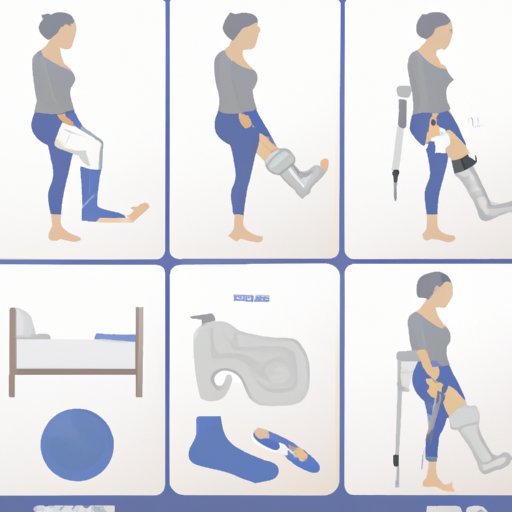Introduction
A sprained ankle is an injury to one or more of the ligaments in the ankle joint. It can be caused by suddenly twisting the ankle, rolling it inwards or outwards, or landing on it awkwardly. Sprained ankles are common, especially in athletes, and can range from mild to severe. Mild sprains may heal on their own with proper care, while more serious sprains may require medical treatment.
At-home care for a sprained ankle is beneficial because it can help reduce swelling, speed up healing, and reduce your risk of reinjury. Taking good care of your ankle at home can also prevent the need for medical intervention. This article will provide an overview of how to take care of a sprained ankle at home.

Rest the Ankle and Keep it Elevated
The most important thing you can do for a sprained ankle is to rest it. You should avoid putting weight on the ankle as much as possible. This means avoiding activities such as running, jumping, or sports that involve a lot of movement. You should also limit walking as much as possible.
It is also important to keep the ankle elevated. This means propping up your foot so that it is slightly higher than your heart. This helps reduce swelling and pain. You can do this by lying down and placing a pillow under your ankle, or using a recliner chair.
Apply Ice to Reduce Swelling
Applying ice to the affected area can help reduce swelling and pain. An ice pack or cold compress can be used for this purpose. The ice should be applied for about 20 minutes at a time, several times a day. Make sure to wrap the ice pack in a thin cloth or towel to protect your skin.
Compress the Ankle
Wrapping a bandage or elastic support around the ankle can help reduce swelling and provide additional support. It is important to make sure the bandage is not too tight, as this could cut off circulation. If the bandage feels too tight, loosen it and try again.
Take Anti-Inflammatory Medication
Over-the-counter medications such as ibuprofen or naproxen can be taken to reduce inflammation and pain. Make sure to follow the directions on the label and talk to your doctor if you have any questions.

Perform Gentle Range of Motion Exercises
Gently moving the ankle in small circles or side-to-side motions can help increase range of motion over time. Start slowly and gradually increase the movements as you feel comfortable. Avoid any activities that cause pain or discomfort.
Use Crutches or a Cane
Using crutches or a cane can help take weight off your ankle when walking. Make sure the crutches or cane are properly fitted to ensure they are providing the right amount of support.

Wear a Brace or Boot
Braces and boots can help support the ankle and help it heal. They come in various shapes and sizes, so make sure to get the right fit for your ankle. Your doctor can help you choose the best option for you.
Conclusion
At-home care is an important part of recovering from a sprained ankle. Proper rest and elevation, application of ice, compression, anti-inflammatory medications, range of motion exercises, use of crutches or a cane, and wearing a brace or boot can all help reduce swelling, speed up healing, and reduce your risk of reinjury. Following these steps can help you recover quickly and safely.
(Note: Is this article not meeting your expectations? Do you have knowledge or insights to share? Unlock new opportunities and expand your reach by joining our authors team. Click Registration to join us and share your expertise with our readers.)
